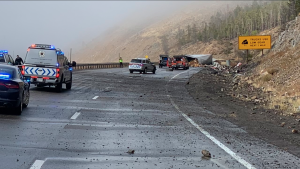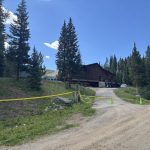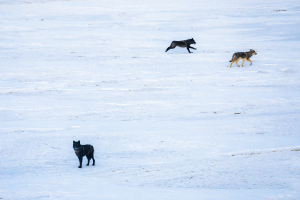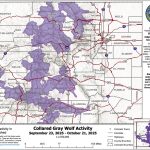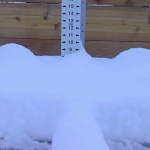Photo in Breckenridge prompts officials to issue warning that moose in water pose a serious threat

Red White & Blue Fire Protection District/Courtesy photo
A photo of a man fishing in Breckenridge near a moose caused Red, White & Blue Fire Protection District to issue a warning to residents and visitors that moose pose a serious threat even when they are in water.
When crews arrived at Sawmill Reservoir around 1:30 p.m. on Thursday, June 8, the moose was unable to be located. Unlike an incident in May 2022 where a moose injured a trail runner near Breckenridge, the moose did not charge or trample anyone, according to a social media post by Red, White & Blue Fire Protection District.
Rather, officials wanted to use the photo as an educational opportunity to remind people that moose can swim more quickly than the fastest Olympic swimmers. Moose can swim up to 6 mph, according to the National Park Service, and they can run at speeds of up to 35 mph, posing a significant threat on land and in the water.
Hollow hair fibers aid moose with floatation, and moose are often spotted in lakes feeding on sodium-rich aquatic vegetation or cooling off on hot days.
“The water serves as protection and comfort for (moose),” according to a statement released by Red, White & Blue. “Most of their predators cannot swim as fast or would be swept away in a river current. … Be aware in your environment, especially wet waterways, and keep your distance.”
The district wants people to remember to stay at least 25 yards away from a moose and never act aggressively toward them. If a moose is agitated and looks like it may attack, run away, or take cover behind a solid object. Don’t stand your ground. It’s alright to run away from a moose, according to the post.
If a moose attacks and you cannot get away, curl up in a ball and protect your head and neck with your arms.
Taking caution
Moose are often found in areas with sagebrush, high in the mountains above timberline and in areas with willow, aspen, pine and beaver pond habitats.
Moose are known to defend themselves and their young aggressively, according to Colorado Parks and Wildlife. Bull moose are known to be aggressive during mating season in the fall.
Signs of an aggressive moose include laid back ears, raised hairs on the neck, cocked heads, rolling eyes and snout licking. Officials encourage people to avoid moose that are behaving belligerently or abnormally and ask pet owners to keep dogs on leashes since moose react to dogs in the same way they react to wolves.
Hunters are reminded that illegally killing a moose results in a fine of $1,370, but Colorado Parks and Wildlife handles accidental kills that are reported immediately differently than when a hunter leaves an animal in the field and is apprehended by other means. For any hunter who kills a moose accidentally, officials ask hunters to report the incident to Colorado Parks and Wildlife. A killed moose should be field dressed immediately to prevent spoilage of the meat.
Wildlife viewing
For those who want to view moose from a safe distance, Colorado Parks and Wildlife encourages them to look for moose tracks, droppings and willow branches that have been eaten. Moose tracks often are very large and often show dewclaws in snow or mud.
Wildlife viewers should find a high spot that looks down into drainages to view them from a safe vantage point. Moose can also be viewed from a vehicle by driving slowly on U.S. National Forest Service roads that parallel drainages.
When recreating near moose, move slowly and do not walk directly at them.
Moose will charge vehicles if they are too close or feel threatened.
History of moose in Colorado
According to Colorado Parks and Wildlife, moose populations are found in Colorado thanks to state reintroduction efforts. Up until the late 1970s, stray moose were known to wander into northern Colorado from herds in Wyoming, but they never held a presence in large enough quantities to establish a stable population in the state.
In 1978, Colorado wildlife managers arranged for a transplant of a dozen moose to Colorado’s North Park region near Walden, according to Parks and Wildlife reports. The next year, 12 more moose were released in the Illinois River drainage. Another dozen were released in 1987. Between 1991 and 1992, nearly 100 moose were released in southern Colorado near Creede.
There are now 3,000 moose statewide.

Support Local Journalism

Support Local Journalism
As a Summit Daily News reader, you make our work possible.
Summit Daily is embarking on a multiyear project to digitize its archives going back to 1989 and make them available to the public in partnership with the Colorado Historic Newspapers Collection. The full project is expected to cost about $165,000. All donations made in 2023 will go directly toward this project.
Every contribution, no matter the size, will make a difference.

